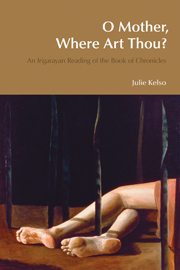Book contents
- Frontmatter
- Dedication
- Contents
- Acknowledgments
- INTRODUCTION: A QUESTION OF SILENCE
- PART I FEMINISM, PSYCHOANALYSIS, AND THE HEBREW BIBLE: “INTRODUCING” LUCE IRIGARAY
- Part II OUR PRODUCTION OF A PAST, IN THE PRESENT OF ANALAYSIS: ENGAGING WITH THE BOOK OF CHRONICLES
- Conclusion
- Notes
- Bibliography
- Index of References
- Index of Authors
Conclusion
- Frontmatter
- Dedication
- Contents
- Acknowledgments
- INTRODUCTION: A QUESTION OF SILENCE
- PART I FEMINISM, PSYCHOANALYSIS, AND THE HEBREW BIBLE: “INTRODUCING” LUCE IRIGARAY
- Part II OUR PRODUCTION OF A PAST, IN THE PRESENT OF ANALAYSIS: ENGAGING WITH THE BOOK OF CHRONICLES
- Conclusion
- Notes
- Bibliography
- Index of References
- Index of Authors
Summary
In both the genealogical discourse (1 Chronicles 1–9) and the narrative section of Chronicles (1 Chronicles 10–2 Chronicles 36), the “feminine” is understood primarily as the symbolic (re)producer of the masculine for man: “she” is the (silent) mother of sons. Overwhelmingly, women are associated with this symbolic function. At the same time, however, the maternal body itself is rarely present in this construction of religio-political origins. Beginning with Adam (1 Chron. 1:1), with no sign of Eve, and beginning again with the murder of Saul (1 Chronicles 10), the one who inquires of the feminine, and his line, our analysand betrays his desire and indeed need for the recognition of paternal origins only. I have argued that while the disavowal and repression of corporeal maternal origins, along with the primary association of the “feminine” with the maternal function for men may seem like a contradiction, these two features of the textual discourses of Chronicles are in fact logically co-extensive. “Woman” is interned as the Symbolic site of reproduction (of the son), while her reproductive body represents the un-representable within that Symbolic order: the maternal body constitutes the principal silence of this masculine discursive production of the past. In other words, “woman” as the son's mother, is the silent mother.
- Type
- Chapter
- Information
- O Mother, Where Art Thou?An Irigarayan Reading of the Book of Chronicles, pp. 212 - 215Publisher: Acumen PublishingPrint publication year: 2008



